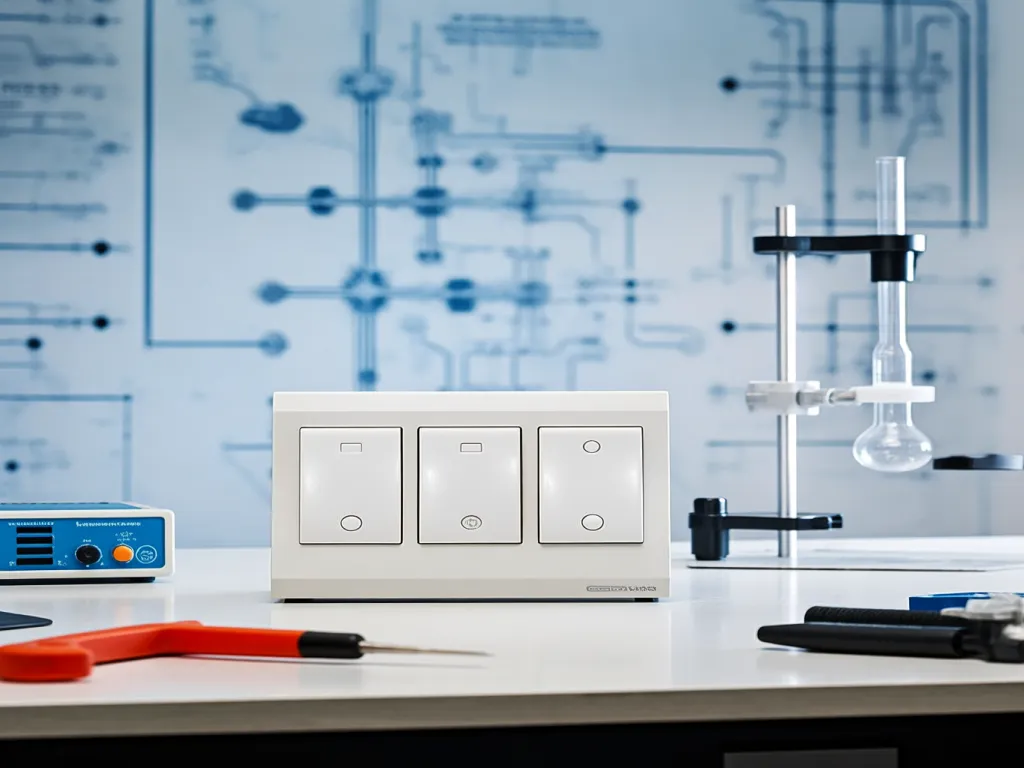Switch Button Push: From Theory to Tech Triumphs
Ever pressed a button and wondered how a simple click could control entire circuits? Welcome to the world of Switch Button Push – the unsung hero of electronics. This guide isn’t just about how these tiny switches work; it’s a deep dive into their real-world magic. From your morning coffee maker to industrial robots, Switch Button Push devices are everywhere. Ready to explore how they tick, where they shine, and how to pick the perfect one? Let’s get started!

How Switch Button Push Works: Mechanical Action, Internal Structure, and Signal Transmission
Ever wondered how a simple press of a button can control the flow of electricity in your gadgets? The switch button push, a seemingly humble component, is actually a marvel of engineering that bridges the gap between human interaction and electronic circuitry. Let’s dive into the nitty-gritty of how this tiny yet powerful device operates.
At its core, a switch button push functions through mechanical action. When you press the button, you’re initiating a physical movement that triggers a change in the electrical state of the circuit. This action is akin to flipping a switch in your mind—except here, it’s a tangible, measurable event. The button’s design ensures that this movement is precise and reliable, every single time.
Now, let’s peek inside the switch button push to understand its internal structure. Imagine a small chamber housing two or more metal contacts, separated by a tiny gap when the button is at rest. These contacts are the heart of the switch, responsible for conducting electricity when they touch. Surrounding these contacts are springs or elastic materials that provide the necessary force to keep them apart until you press the button.
When you apply pressure to the button, it compresses the spring or elastic element, bringing the contacts together. This is where the magic happens—the moment of connection. As the contacts meet, they form a complete electrical path, allowing current to flow through the circuit. It’s like opening a gate in a dam; once the gate is open, water (or in this case, electricity) rushes through.
But how does this connection remain stable while the button is pressed? The answer lies in the design of the contacts and the materials used. High-quality switches employ contacts made from durable, conductive metals like silver or gold-plated alloys. These materials not only ensure good electrical conductivity but also resist wear and tear, ensuring a long lifespan for the switch.
The signal transmission process is equally fascinating. Once the contacts are closed, the electrical signal can travel uninterrupted through the circuit, powering whatever device or system the switch is connected to. This signal can be a simple on/off command, like turning on a light, or it can be part of a more complex sequence in industrial machinery or automotive systems.
What’s even more intriguing is how the switch button push can be designed to handle different levels of current and voltage. By adjusting the size and material of the contacts, as well as the strength of the spring, manufacturers can tailor switches to specific applications. For instance, a low-power switch in a remote control might use tiny, delicate contacts, while a high-power industrial switch would require robust, thick contacts capable of handling large currents without overheating.
Have you ever thought about how a single press can mean so much in the world of electronics? It’s a testament to the ingenuity of engineers who have perfected the switch button push over decades. Whether you’re pressing a button on your smartphone, a microwave oven, or a massive piece of factory equipment, the principle remains the same—mechanical action meeting electrical precision.
So, the next time you press a button, take a moment to appreciate the complex dance happening inside. From the initial press to the closing of contacts and the seamless transmission of signals, the switch button push is a silent hero in our electronic world.

Applications of Switch Button Push in Diverse Electronic Circuits
When we think about the humble switch button push, it’s easy to underestimate its role in the vast landscape of electronic circuits. Yet, this tiny component plays a pivotal part in ensuring the smooth operation of countless devices across various industries. Let’s dive into the fascinating world of switch button push applications, exploring how it’s indispensable in home appliances, industrial control systems, and automotive electronics.
Switch Button Push in Home Appliances
Have you ever paused to consider how often you interact with switch button pushes in your daily life? From the moment you wake up and turn on your coffee maker to the late-night flick of a lamp switch, these components are everywhere. In home appliances, switch button pushes are designed for durability and ease of use. They control everything from the power on/off functions to more complex operations like selecting washing cycles in a laundry machine or adjusting temperature settings in a microwave. The design of these switches often incorporates materials that withstand frequent use and resist wear and tear. For instance, a refrigerator’s door light switch might use a robust plastic casing to endure countless openings and closings. Meanwhile, the tactile feedback provided by a well-designed switch ensures users can operate appliances confidently, even in low-light conditions.
Industrial Control Systems: Precision and Reliability
Move beyond the home, and you’ll find switch button pushes playing an even more critical role in industrial settings. Here, precision and reliability are non-negotiable. Industrial control panels rely heavily on these switches to manage machinery, monitor processes, and ensure safety protocols are followed. Whether it’s starting a conveyor belt in a manufacturing plant or activating an emergency stop in a hazardous environment, the switch button push must perform flawlessly every time. In these applications, switches are often engineered to meet stringent standards, including resistance to dust, moisture, and extreme temperatures. They might feature metal housings for added durability and sealed contacts to prevent contamination. For a deeper understanding of industrial switch standards, you may refer to resources like the IEC (International Electrotechnical Commission) guidelines. The choice of switch type—be it a momentary push button for transient actions or a maintained switch for continuous operation—depends on the specific requirements of the industrial process.
Automotive Electronics: Safety and Convenience
Now, let’s shift gears and explore the automotive sector, where switch button pushes contribute to both safety and convenience. In modern vehicles, these switches control a myriad of functions, from adjusting the climate control system to activating the power windows. More critically, they’re integral to the operation of safety features like headlights, turn signals, and hazard lights. Automotive switches are designed to withstand the rigors of the road, including vibrations, temperature fluctuations, and exposure to the elements. They often incorporate advanced materials like silicone for improved tactile response and longevity. Moreover, with the rise of electric and autonomous vehicles, the role of switch button pushes is evolving. Touch-sensitive switches and capacitive buttons are becoming more prevalent, offering a sleeker design and enhanced user experience while maintaining the reliability expected in automotive applications.
The Unseen Hero in Everyday Technology
As we’ve seen, the switch button push is far from a mundane component. Its versatility and reliability make it an unseen hero in the world of electronics, quietly ensuring that our devices function as intended. Whether it’s the comfort of a well-lit room, the efficiency of an industrial process, or the safety of a journey on the road, the switch button push is there, making it all possible. So, the next time you press a button, take a moment to appreciate the engineering marvel behind it. After all, it’s these small components that collectively enable the seamless operation of the technology we rely on every day.

Types, Specifications, and Testing Guide for Switch Button Push
When it comes to selecting the right switch button push for your electronic project, understanding the different types, specifications, and testing methods is crucial. Whether you’re designing a simple home appliance or a complex industrial control system, the right switch can make all the difference. Let’s dive into the world of switch button pushes, exploring their types, specifications, and how to test them for optimal performance.
Common Types of Switch Button Push
Button-Type Switches: These are perhaps the most familiar. You press them to close a circuit and release them to open it. They’re commonly used in calculators, remote controls, and various consumer electronics. Button-type switches come in various sizes and shapes, from tiny tactile buttons to larger, more robust pushbuttons. For example, our 10mm 1NO1NC illuminated push-button switch offers a compact yet robust solution for many applications.
Toggle Switches: Unlike button-type switches, toggle switches maintain their state (on or off) until manually changed. They’re often used in applications where a persistent state is desired, such as in power supplies or light switches. Toggle switches can be single-pole single-throw (SPST), single-pole double-throw (SPDT), or even more complex configurations.
Rotary Switches: These switches allow for multiple positions, each corresponding to a different circuit configuration. They’re commonly found in audio equipment, where they’re used to select different inputs or outputs. Rotary switches offer versatility and can handle multiple functions within a single compact unit.
Specifications to Consider
When selecting a switch button push, several key specifications should guide your decision:
Rated Current and Voltage: These indicate the maximum current and voltage the switch can safely handle. Exceeding these limits can lead to switch failure or even safety hazards. Always choose a switch with ratings that exceed your application’s requirements.
Operating Force: This refers to the amount of force needed to activate the switch. It’s crucial for user experience, especially in applications where frequent switching is required. Too much force can make the switch difficult to use, while too little can lead to accidental activations.
Electrical Life: This measures how many cycles (on/off operations) the switch can endure before its performance degrades. For applications requiring frequent switching, a switch with a high electrical life is essential. Our momentary 1NO1NC LED push-button switch is designed for long-lasting performance.
Mechanical Life: Similar to electrical life, but focusing on the physical durability of the switch. It indicates how many times the switch can be physically toggled without failure.
Performance Testing and Quality Assessment
Testing your switch button push is vital to ensure it meets your application’s requirements. Here are some practical methods:
Visual Inspection: Start with a simple visual check. Look for any signs of damage, such as cracks, loose parts, or corrosion. A damaged switch is unlikely to perform reliably.
Continuity Testing: Use a multimeter to check the switch’s continuity. With the switch in the ‘on’ position, there should be minimal resistance, indicating a closed circuit. In the ‘off’ position, resistance should be high or infinite, indicating an open circuit.
Operating Force Test: Use a force gauge to measure the exact force required to activate the switch. Compare this to the manufacturer’s specifications to ensure it falls within the acceptable range.
Endurance Testing: Simulate the switch’s expected usage by repeatedly toggling it. Monitor for any signs of wear, such as increased operating force, reduced continuity, or physical damage. This test helps predict the switch’s lifespan under real-world conditions. For switches with advanced features like LED illumination, consider our 12V square dot illuminated LED push-button switch for a reliable and visually appealing option.
By understanding the different types of switch button pushes, their specifications, and how to test them, you can make an informed decision that ensures your electronic project operates smoothly and reliably. Remember, the right switch can enhance user experience, improve safety, and extend the lifespan of your device.
So, there you have it – the full scoop on Switch Button Push devices. From their inner mechanics to real-world applications and smart selection tips, you’re now armed to make informed choices. Whether you’re designing a circuit, troubleshooting a gadget, or simply curious about how things work, understanding Switch Button Push gives you an edge. Ready to put this knowledge to use? Dive deeper into our resources or share your newfound expertise with fellow tech enthusiasts. The world of electronics is vast – and now, you’ve got a key to unlock more of its secrets.


